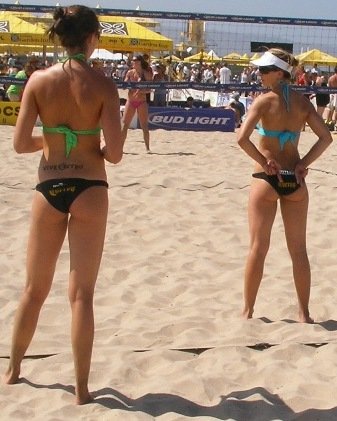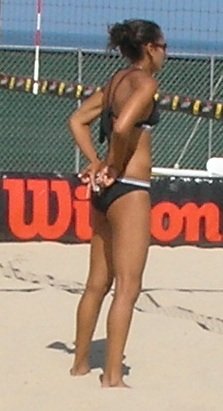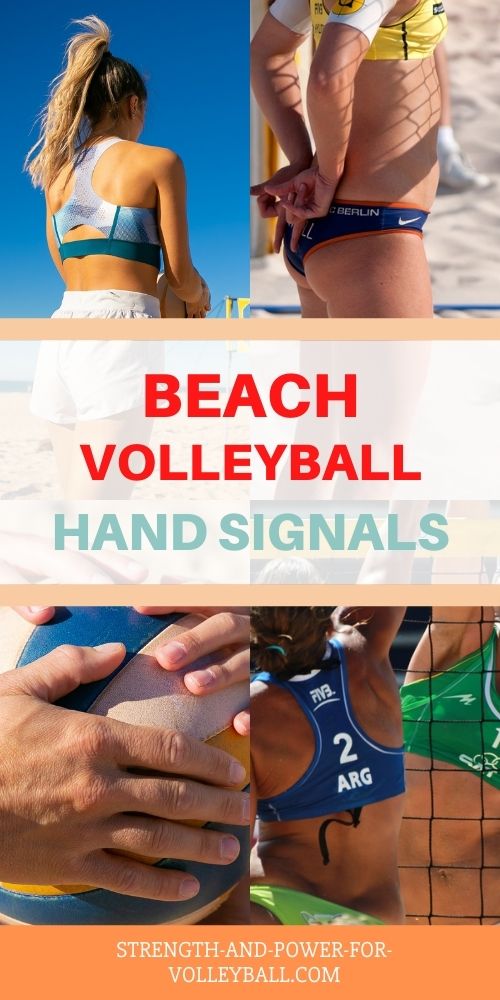Beach Volleyball Hand Signals
Beach volleyball hand signals are important for effectively communicating with your partner and playing defense.
Beach Hand Signals for Doubles Volleyball
Before the serve is usually the best time to signal your partner what you're going to block.
If your partner is serving and you are going to block, stand at the net and signal with your hands what you are going to block.
Signaling 1
Signaling one finger with your left hand means you're going to block line on the right side hitter.
Signaling one finger with your right hand means you're going to block line on the left side hitter.
Signaling 2
Likewise, signaling two fingers means you're going to block angle.
Signaling a fist
A fist means you aren't planning to block. For example, as the attacker
is being set, the blocker pulls off the net to help out with defense.

Defender Signaling the Blocker How to Block
Signaling an open hand
An open hand usually means the blocker is going to take the ball. This
strategy is risky because the defender isn't going to know where the
blocker is going to block. The blocker
basically guesses where the hitter is going to hit at the last second.
If the blocker knows the the hitter well, this strategy is also
effective for "baiting" the hitter into hitting into your block.
Signaling with the thumb
The thumbs are used to show your partner which player you'd like them to serve to.
Basic Blocking Strategies
Basic strategies for blocking angle
When blocking angle, line up on the hitting shoulder of the attacker. At
the last second, jump and reach with both hands penetrating the net
into the angle.
With this technique, what you're trying to do is show that the angle is open and then at the last second penetrate into the angle as much as you can.

Signaling Your Teammate in Beach Volleyball
Basic strategies for blocking line
The technique for blocking line is the same as blocking angle except this time jump at the last second reaching to
intercept the ball that could be
hit down the line.
When first learning techniques for beach volleyball hand signals, youre
simply showing an open shot then at the last second taking it away.
In the beginning, you'll be doing a lot of guessing. After awhile,
you'll get better at being deceptive and reading the hitter and you
won't have to guess quite as much.
Strategies for shorter blockers
If youre a shorter blocker, it might be better to play it safe and stick to
your beach volleyball hand signals.
Especially if your partner is a really good defender, it's usually best
to block safely, taking away some area of the court while your partner
covers the rest.
As a Blocker, Always Take Away Something
If you are blocking line, you must take the line away.
If you're not great at blocking balls, you must still take away area so your partner has a chance to make a defensive play.
If you're a small block, don't underestimate the importance of directing
the ball to your partner. If your block creates an opportunity for your
partner to
make a defensive play on the ball, then you've done your job.
Effective Blocking Considerations
When playing indoor 6's, you go up high with a teammate and sometimes two other teammates to form a wall.
In sand volleyball, blocking is entirely different.
You're blocking all by yourself. To be successful blocking you need to be deceptive.
If you enjoyed these tips and would like to keep it close to you at any time, just save this pin to your Pinterest Volleyball Training Board.
Beach Volleyball Hand Signals for Blocking Both Player's Line
Hiding the block
In doubles, you wait until the hitter is committed to a particular angle
then go after it. If you show your block too early, you become an easy
blocker to hit around.
Bait the attacker
Show line first, then at the moment of contact reach into the angle.
To block line, do just the opposite. Show you're going to block angle then sweep quickly into the line.
Penetrate the net
At the point where your volleyball block
intercepts the ball, you must penetrate the net. If you're blocking
extreme angles, it's difficult to penetrate. But you must penetrate
some, even if it's just an inch or two.
You must block the tight sets
If the set is close or on top of the net, you should get at least a hand
on it. It's important that your opponent respects you as a blocker. A
set tight to the net is an unforced error that must be taken advantage
of.
